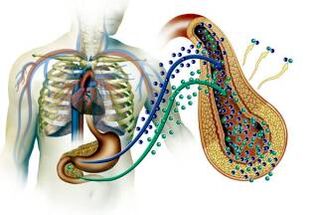Diabetes is a serious disease characterized by insulin deficiency. Due to pathology, hyperglycemia, i. e. increased blood sugar, may occur, which can lead to various metabolic diseases and complications.
Diabetes ranks third in the prevalence after cancer and cardiovascular disease. Currently, more than 100 million people worldwide suffer from this disease. Every 15 years, the number of cases doubles.
There is no drug that completely eliminates the manifestations of diabetes. If the disease is not treated for a long time, irreversible diseases in the blood vessels of various organs will occur.
To pay attention to timely pathological symptoms, you should know what types of diabetes exist.
Types of diabetes

Medically, several types of diabetes are released. The term itself reveals a list of diseases with common characteristics. Diabetes and their types are characterized by the pathological level of blood sugar.
There are many reasons why insulin cannot cause glucose in blood cells. However, the results are always the same: the saturation of the blood saturated sugars and the cells cannot be eaten normally.
When the sugar does not fall into the cells, it pulls water on itself. The blood-filled fluid passes through the kidneys and becomes dehydrated. Despite all the diabetes, there are still symptoms:
- Dry mouth.
- Thirsty.
- Frequent and extensive urination.
Each type of disease is differentiated by its own characteristics on the human body. Diabetes, its types have their own differences, maybe:
- Non-blooded sausage and sugar.
- latent.
- Potentially, it is expressed as susceptibility to the disease.
- Insulin-dependent and insulin-dependent.
- Negative.
- kidney.
- After the operation, it appears after pancreatic surgery.
- Pancreas, expressed in pancreatic lesions.
- Non-pancreatic, has nothing to do with damage to the pancreas.
The first type of diabetes

Insulin-dependent diabetes is called autoimmunity or viral damage that produces insulin to the pancreas. People with type 1 diabetes have no insulin at all, or it is small in size.
Statistics show that type 1 disease occurs at a young age. It depends on symptoms such as frequent thirst, rapid urination, rapid weight loss, hunger and the appearance of acetone in the urine.
The treatment for this disease is to introduce the required hormone dose from the outside. Other therapeutic effects are completely ineffective. The first type of diabetes usually occurs due to genetic susceptibility. This disease causes one or more negative factors, which starts pathological changes in the immune system.
As a result, pancreatic cells deformed and insulin was produced. The lack of hormones leads to the fact that carbohydrates cannot be placed entirely in the body, and the lack of energy is trying to compensate for fat processing.
Toxic substances begin to enter the brain. Therefore, it is very important to continuously control the current state of the human body and the amount of glucose in the blood.
The disease may be due to:
- Infect.
- pressure.
- A sedentary lifestyle.
- Autoimmune disease.
- Genetic.
- Have a meal.
This type of diabetes is at most 15% of the total number of patients. Most of the time, children and adolescents get sick. Diseases arise due to passive lifestyle and constant use of carbohydrates. Obesity and diabetes can occur when taken:
- Soda water.
- Smoked meat.
- Canned products.
- fast food.
Sometimes diabetes, then obesity first occurs. Type 1 disease has these symptoms:
- weakness.
- irritability.
- A feeling of fatigue.
- nausea.
- Enhanced thirst.
- The call to urinate.
Usually, patients lose weight quickly and vice versa. Diabetes may be:
- Main: Genetics, essential.
- Secondary: thyroid, pituitary gland, steroids.
The disease may be mild, moderate or severe. Depending on the nature of the course, the disease is classified into insulin-dependent and insulin-dependent types. Because the blood contains high sugar content, buds and blood vessels are deformed.
Therefore, in many cases, people with type 1 will lose their sight and be almost blind. There are two main manifestations: first, the invasion of the kidney, and then - the failure of the organ. Patients often notice pain and numbness in the limbs. This is due to violations of blood circulation and nerve damage.
If blood flow to the foot is violated, there is a high risk of amputation. For type 1 disease, the blood is full of cholesterol, so in patients with diabetes, stroke or myocardial infarction is not uncommon.
In men with diabetes, yang ot often develops because nerves and blood vessels no longer exist in health. Due to pathology, they appear:
- obesity.
- pancreatitis.
- skin disease.
- Kidney disease.
- Brain disease.
One of the pathology that causes great danger is blood sugar-lowering coma. This condition usually leads to death.
Diabetics should use special equipment created for family status every day to determine blood sugar levels. If necessary, prescribe the sugar content.
If glucose levels increase, insulin injection is required to treat type 1 disease. This hormone is involved in metabolism, allowing the body to process carbohydrates.
If type 1 diabetes is not properly treated, serious complications can occur. In some cases, death is possible. Sometimes, a person needs to be hospitalized to determine the complexity of the situation.
Under fixed conditions, patients will be taught new sugar control skills.
The second type of diabetes

This disease occurs when pancreas is insufficient insulin. The reduction in cell activity of the organ can also aggravate the disease. Usually, pathology is formed due to the hereditary non-consumption of hormones by tissues.
Fabrics receiving insulin have insulin receptors. Due to the pathological emergence of these receptors, tissue immunity to insulin develops. The secretion of hormones does not decrease, resulting in a relative insulin deficiency.
First, in obese patients, the function of insulin receptors has decreased. Overflow can cause excessive glucose in the blood, and non-structural tissues cannot allow glucose to enter the cells.
As sufficient amounts of insulin are required to bring sugar into the cells, the excess product of the pancreas begins, which is wrapped with beta-cell depletion.
Type 2 of diabetes in medicine is not considered genetic pathology, but a wrong lifestyle disease. Even if there is a serious inheritance existing, such violations will not be formed if:
- The use of desserts and other "fast" carbohydrates is limited.
- No overeating.
- Have continuous control of weight.
- Physical exercise continues.
Symptoms of type 2 diabetes are not specific. The person did not notice their performance in most cases because there was no significant deterioration in the wellbore. But knowing the symptoms, you can’t miss their appearance moments and consult your doctor in time to determine the concentration of glucose in the blood. Therefore, the success of diabetes will be compensated and the risk of complications will be greatly reduced.
The main manifestations of this pathology:
- Dry mouth.
- The increase in urine volume makes a person constantly wake up at night.
- Strong thirst.
- Itching of the mucosa.
- Strong appetite associated with failure of leptin synthesis.
The presence of diabetes can also be discussed:
- The wound is recovered slowly.
- plan.
- Yang ot.
- Fungal infection.
Due to a stroke or heart attack, the disease can be detected for the first time when entering the hospital. This disease indicates that diabetes is in a serious stage.
The usual symptoms only show an increase in renal threshold above sugar levels -10 mmol/l. As glucose increases, it appears in the urine. If this value does not reach 10 mmol/L of blood, then a person will not feel physical changes.
It can be noted that random installation of type 2 diabetes is very common.
For diabetes therapy, 2 types are used: Use the following methods:
- Biguanides.
- Thiosolidindo.
- Cost sulfate.
- Clay.
Gestational diabetes
The pregnancy form of the disease can occur in pregnant women. Pathology is formed due to insufficient insulin production, which is needed to regulate blood sugar.
During pregnancy, the female body is forced to produce a lot of insulin, which provides the fetal need. This process is particularly important in the second half of the year.
If insulin is lacking, the glucose levels in the blood are increasing, giving a chance to develop pregnancy-type diabetes. This disease usually occurs independently immediately after delivery.
This is a feature that distinguishes it from other types of diabetes, which are chronic.
Potential diabetes

Many unclear moments are associated with diabetes. The most common types of disease are the first and second types. It is worth noting that there is an intermediate type of this dangerous disease called LADA diabetes.
This disease occurs in adulthood. Multiple of this disease are dangerous because for a long time it can be masked as type 2 diabetes. The underlying form of the disease is very difficult.
LADA is a serious autoimmune disease. The immune system begins to attack its organisms, constantly destroying the beta cells that produce insulin in the pancreas. However, such patients can have no insulin injections for a long time without insulin injections, which is different from those with type 1 diabetes.
Through the underlying form of diabetes, the immune process proceeds very slowly. On the pancreas, working beta cells are retained. The patient showed medication for the second diabetes, which was used in patients with diabetes. Over time, antibodies destroy more and more beta cells, resulting in severe reduction in insulin volume and inevitable insulin treatment.
Hidden Diabetes
Hidden diabetes has another name: potential or sleeping. This pathology is early diabetes.
Due to the initial stages of diabetes, sugar and its blood indicators will never exceed the norm. In the initial stages of the disease, violation of glucose tolerance was recorded. Furthermore, after sugar load, a person's blood is very slow, but the glucose concentration decreases.
These people are highly likely to have diabetes in 10-15 years. This disease does not require specific complex therapies, but continuous medical observation is important. Over the years, potential types of diabetes may occur.
To develop it, sometimes enough to survive a severe neurological disease or a viral infection.
Non-Adal diabetes
Non-assisted diabetes is a pathology that is caused by the absolute or relative lack of vasopressin, a hormone, a hormone with antidiuretic effects. People suddenly urinate and have thirst. Sleep is obviously ruptured and a person is usually unable to recover his strength.
Release about 6-15 liters of loose light urine every day. There is also a lack of appetite and weight loss. A person is often tired and troubled, with dry skin and lack of sweating.
Subcompensated diabetes
Diabetes is a disease that includes impaired carbohydrate metabolism. All medical measures are designed to normalize them. It is very difficult to achieve stable results. Due to prolonged treatment, the levels of carbohydrate metabolism fluctuate and have different values.
There are several forms that will allow you to compensate for this dangerous disease. We're talking about:
- Improperty.
- Subcompensation.
- Compensation form.
The metabolic form is characterized by little improvement in carbohydrate metabolism. The concentration of glucose in blood, acetone and sugar is found in the urine.
Subcompensated diabetes is a pathology in which blood sugar is not much different from the norms and there is no acetone in the urine. With the compensation form of disease, a person has normal glucose, and no sugar in his urine.
Negative diabetes
The disease can be distinguished by the nature of unstable and stable courses. Unstable disease types are characterized by significant fluctuations in glucose in the blood every day.
In such people, hypoglycemia occurs, usually at dinner. Late at night and early morning, there was a strong thirst and super glymp. The hidden process of the disease is often accompanied by the formation of ketoacidosis, which often leads to diabetic coma.
Rapid replacement of hypoglycemia and hyperglycemia is a characteristic of youth and naive diabetes. The stability of the disease process is characterized by its average stage. The disease continues when it is severe.























